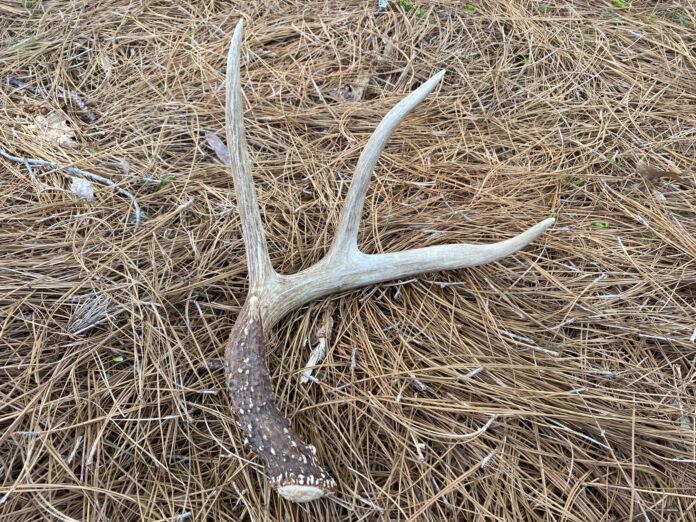
Late winter and early spring can often be a dull time for hunters and outdoor enthusiasts. Deer season is over, and turkey season has yet to begin, but people may still be looking for an excuse to get outside. Hunting for deer antler sheds is a growing sport and is a great way to spend time outdoors and begin scouting for the next season. Not only does it offer the excitement of searching, but the sheds also make great decoration pieces for homes and offices.
What causes antler shedding?
In the Southeastern United States, white-tailed deer antler shedding occurs between January and March. Variations between regions can occur. However, antler drop within a specific area will occur around the same time each year. As with all functions of antler growth in white-tailed deer (growth, hardening, and shedding), testosterone levels regulate the antler cycle. Seasonal changes in photoperiod (length of day) will stimulate changes in testosterone levels.
After breeding season, testosterone levels are reduced, stimulating cells called osteoclasts to break down the tissue between the burr (base of antler) and pedicle (antler growth plates). This region of separation is referred to the abscission line. Eventually, the antler will shed, or drop off from its own weight. Both antlers may shed at the same time or at different times separated by days or weeks. After the antlers have been shed in late winter or early spring, new growth begins immediately in preparation for the next breeding season.
If the antler breaks off prematurely, damage to the pedicle can occur and affect future year’s antler development. For this reason, antler traps are not suggested. Research by The Deer Lab at Auburn University confirmed that damage to the pedicle was the leading cause of spike-on-one-side antlers, accounting for 48 percent of all skulls examined and 79 percent of skulls that the researchers could attribute a probable cause of spike on one side.
Prepare for the hunt
People should begin searching for sheds as soon as they see deer in their area losing their antlers. Keeping game cameras in the woods past hunting season will help determine the ideal time to begin hunting. Antlers are high in calcium and phosphorus, so it makes them a target for rodents to gnaw. Also, antlers that have been left in the sun too long will become bleached and lose their natural color.
Focus shed hunts to areas where white-tailed deer frequent. This could be in bedding areas, feeding areas, or travel corridors. Searching for antler sheds on overcast days is also a great tip. This will reduce the sun glare and make them easier to see. Also, a recent rain will wet the antlers and darken them, making them easier to see. Finally, using fire during the growing season is not only a great forest management tool, but it also removes the understory and litter, making antler sheds easier to find.
Even with this knowledge on sheds, still be prepared to walk long distances. A dog that has been trained to smell sheds is a good resource and time saver, but not a necessity. For information on training dogs to hunt antler sheds, check out the Alabama Extension Management Minute video on hunting sheds at www.aces.edu.





















